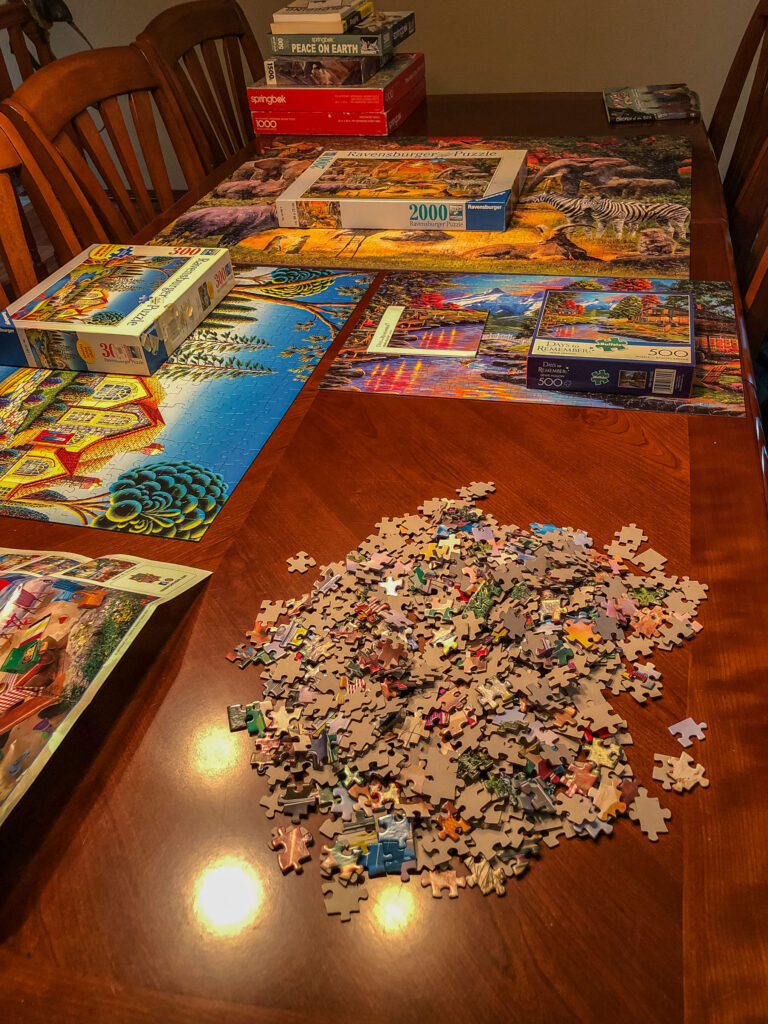You may recall from an earlier post that I developed my own monthly challenge called OcTraPiMo (October Trash Pick-up Month). The experiment was to collect trash on daily neighborhood walks with my dog. This year, I’m hoping to reduce emotional clutter by cleaning the house.

What Is Clutter?
Anything in your home that you love, need, or use, is not clutter. Everything else is and needs to go. Emotional clutter, however, is way more complicated. And has much deeper roots. If you’re anything like me, every time you think of removing precious stuff from your home, you may feel a host of emotions ranging from uncertainty to panic.
“I just know as soon as I get rid of it, I’ll need it.” Not sure what this is called, maybe unreasonable anticipation?
“Nobody notices that crack in the frame except me.” This is a lie we tell ourselves to hide the truth.
“You can never have too many dog toys.” This one needs no analysis. Or maybe it does. Just sayin’.

“My grandmother gave that to me right before she died. I can’t just throw it out.” Emotional attachment to someone who is no longer there, feeling like the object somehow represents the missing person.
“I wear that every other December when we host for the holidays. It’s getting snug.” Um, perhaps unrealistic expectations.
There must be psychological names for such examples, but that does not matter. Can you recognize yourself in any of them?
How can we bust through the clutter in our home when the thought of letting go of anything causes emotional turmoil? The answer may lie in unearthing the reason for the clutter and removing its tough outer shell.
From Clutter to Clarity
One place to start might be Kerri Richardson‘s book, From Clutter to Clarity. Of all the resources I’ve studied, including Marie Kondo’s wildly popular KonMari method, Richardson gets at why we have clutter where we do. Her “common clutter hotspots” cheat sheet at the end of the book pointed me toward two chapters that spoke volumes.
I didn’t realize (until this week) that I have two clutter hotspots: our office (what Richardson refers to as the money center) and my mind. Once I identified the truths in those two chapters, I was able to shed grief, guilt, and shame before I could tackle the KonMari method. Now that I have embraced the why behind the clutter accumulation and have created a strong plan to deal with it, I can move forward with the how.

Choosing a Path to Reduce Emotional Clutter
Brooks Palmer, author of Clutter Busting and Clutter Busting Your Life, offers some practical advice for getting rid of clutter. He stresses the importance of asking yourself curious questions about the items in your home. Questions such as how do you feel when you read/hold/see this item? Does it represent someone you no longer feel you are or something you want to change? Who pays the highest price for holding onto the item beyond its welcome?
If the answer is you then it’s time to let go.
Marie Kondo, Japanese consultant and creator of The KonMari Method, suggests that items in your home which don’t “spark joy” do not belong in your home. She asks participants to commit to tidying everything all at once, whereas KC Davis, author of How to Keep House While Drowning, insists that you are not lazy if you struggle to keep a clean house and you can take as long as you need to.
When considering the right path for you, remember that whatever system you choose must work for you or you won’t follow through. Perhaps you could use a five-minute action to get over any inertia. This is my plan.

KonMari Method
Kondo suggests a clutter-busting method that includes going through everything in your house, garage, shed, and car(s) in five steps, in the following order:
- Clothing
- Books
- Papers
- Miscellaneous items
- Sentimental value
She suggests pooling together similar items so you can see everything you have, all at once. As you go through each pile (you can have each member of your household do their own clothes, books, and papers), ask “Does this spark joy?” Keep anything you love or that makes you happy. Put the rest into “Maybe” or “Discard.”
You might also want to consider whether items in the discard pile should end up in the garbage, in a garage sale, as a donation, or to trade. But initially, your priority is to look for what you will keep.
And don’t overlook the option of starting small: your desk. A drawer in your file cabinet. A shelf behind your desk. If doing the entire household all at once stresses you out, commit to what you CAN do to move forward.

NoCluHoMo to Reduce Emotional Clutter
During the coming months (until I finish – doing this during the holidays is a little intimidating but I’m using the five-minute action as my guide) I’m conducting an experiment I’ve dubbed NoCluHoMo (No Clutter in the House Months). I have done well with clothing and books. Where I get stuck is Kondo’s third category, papers.
In particular, my manuscripts. I always mean well, but whenever I get to this category, I want to skip over it, something Kondo would advise against. All the other clutter-busting authors would probably say, “Just keep going.” So that’s what I plan to do.

If you feel like clutter-busting would help you clear your emotional clutter, and you’ve found a path that works for you, consider joining me during NoCluHoMo. It doesn’t have to be in November, it can be whenever it works for you. After all, give yourself a present — there’s no better time than the present. As always, feel free to share comments that might help others get past their blocks. I love hearing from readers.


I love this blog. Great pictures as well. You may want to listen to the podcast – the minimalists. I love their website and resources as well. They also have a 30-day game to help you to decluster your life. Anything goes.
I consider myself a minimalist. I started the process 5-year ago and I keep on it. I am still doing it. This is a process and a lifestyle. I did it small steps at a time, no big step. It would not have worked with me. I believe because I have moved so many times between my 20s and 50s, it was easier to achieve my goal. I also have a minimalist approach to my self-care. It was easy to do as I never use too many beauty products. So much fun to do and continue to do it. Love the minimalist lifestyle.
Thanks for the suggestion, Silvie-Marie! I believe I have seen that game — if I recall it started with “get rid of one item on day 1, 2 on day 2” etc. so that you amass more and more that you’re removing. I like the “game” idea — Gamifying ANYTHING makes it more fun. I wonder sometimes what it would be like to live in a tiny home but we couldn’t do that and still run our gym — the exercise equipment would take up more room than any tiny home itself! I am drawn to the minimalist concept, but GETTING there is such a challenge. Good for you!